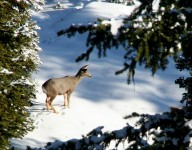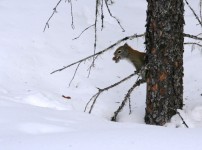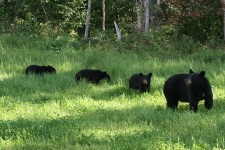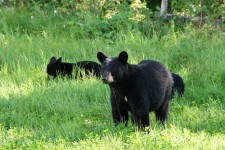Certain animals are elusive–lynx, bobcats and most notoriously wolverines. I’ve been lucky enough to see two wolverines in all of my hiking–way across a valley on a mountainside in Denali National Park. Without binoculars, I would have thought they were bear cubs.
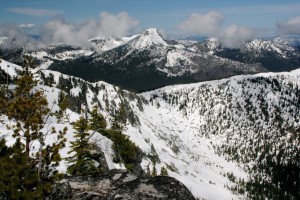
High-elevation whitebark pine forests with steep slopes are favored locations for wolverines in the summer.
Wolverines and bears share a few physical traits–a thick body, short legs, short ears and a broad, flat head. Beyond that, the wolverine has a distinct foot-long bushy tail and an arched back. Wolverines are also smaller at 15 to 30 pounds and 36 to 44 inches in length (which includes the tail).
Wolverines have glossy, dark brown fur with a silvery or grizzled face mask and buff-colored lateral stripes along their flanks. They also have large feet with thick, non-retractable claws for digging, holding prey and climbing trees.
Their elusive nature isn’t because they hide most of the time. Wolverines are known to cover more ground than any other carnivore–sometimes 30 to 40 miles a day in search of food.
Wolverines travel their home range in a shuffling lope and only slow down to investigate a potential meal, to scent mark, or when they tire in soft snow. They travel their entire home range in seven to ten days often crisscrossing their own trails. Home range size varies depending on habitat. In Montana, the home range of a male wolverine averages 163 square miles and a female’s averages 150 square miles. In some areas farther north, home ranges are as large as 400 square miles.
In order to cover long distances each day, wolverines alternate movement with rest. They are on the move for three- to four-hour intervals and then rest for equal amounts of time both day and night, all year long. However, wolverines increase nocturnal activity on clear nights, full moon nights, nights with northern lights or when hungry.
Even as a carnivore, wolverines need to rest in safe and secure places. They find cavities to rest in, dig holes in the snow, rest in trees, and occasionally rest atop snow in areas of good visibility.
Wolverines continuously patrol their territories to find food. They scavenge or kill ungulates (caribou, moose, deer, elk), and smaller prey that includes snowshoe hares, lemmings, voles, ground squirrels, marmots, porcupines and ptarmigan. They also eat berries, fish and nuts.
Wolverines aren’t picky, they are opportunistic feeders eating whatever they can find. In winter and spring their main food is carrion. Their keen sense of smell allows them to find winterkill, unattended carcasses cached by lynx and fox, and fresh carcasses.
Their vicious reputation comes from their nature to confront and steal carcasses from bears, cougars, wolves and lynx. Wolverines first try to scare away the other carnivore by charging rapidly, arching its back, snarling, growling, drooling and showing its impressive teeth. If that doesn’t work, the wolverine keeps returning again and again to intimidate the opponent.
If a wolverine cannot consume the entire carcass, it will drag it (if less than five times its body weight) to a cave or other cache site. The cached food is for winter when food is harder to find–though they can quickly dig through eight feet of snow to reach the carcass.
Often tracks in winter reveal the presence of wolverine in their favorite habitat–high-elevation, open terrain with steep slopes and coarse talus. Both the Selkirk Mountains and the Cabinet Mountains harbor such habitat and observations of wolverines have been verified in both. Idaho Fish and Game estimates three to five wolverines living in the Selkirk Mountains and one to two wolverines living in the Cabinet Mountains. Someday, I may be lucky enough to see one of those elusive wolverines.

